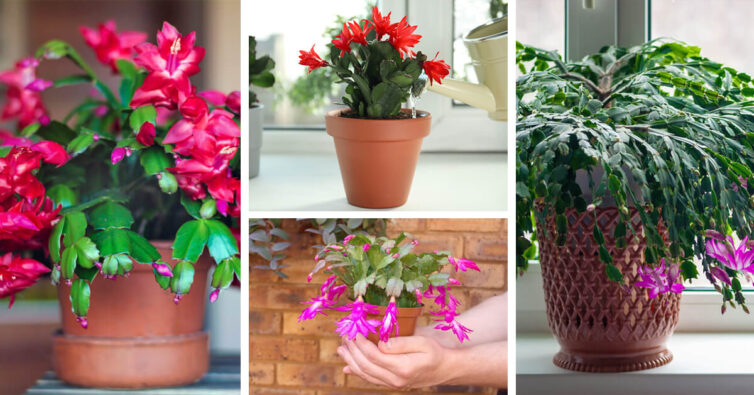It’s time to deck the halls, not just on holidays but all year round. So-called “holiday plants” like Christmas Cactus have a reputation for blossoming around a specific holiday. Other examples include poinsettia, amaryllis, and cyclamen. However, there’s nothing keeping the indoor gardener from getting any of these whenever they wish!
Even without flowers, you have a lovely display of green. When there are gray clouds or snow outside, the Christmas Cactus’ jade hue is sure to brighten things up. In terms of flowers, traditional Christmas Cactus come in pink, purple, and sometimes red. You can grow and care for them indoors with ease and a little know-how.
Is Christmas Cactus Pet Friendly? Unlike poinsettias, the ASPCA says Christmas Cactus is not toxic to cats or dogs. The only problem occurs when eaten in large quantities. In this case, your pet may experience diarrhea and vomiting.
Christmas Cactus Care
You want to care for your indoor Christmas Cactus, keeping it healthy and blossoming brightly. So what are the keynotes to Caring for a Christmas Cactus indoors?
- Fertilization: Once buds form, the plant benefits from high potassium fertilizer every two weeks. Liquids are best. Look for 10-10-10 or 20-20-20 and dilute them by 50%.
- Light: The Christmas Cactus is a bit shy. It doesn’t fare well in the center stage of sunlight. Rather, it needs moderate light like what an east-facing window generates.
- Soil: Watch for lightweight potting soil or mixes suited to succulents. Mix in a little humus, and your plant will thank you.
- Temperature: During the day, the Christmas Cactus thrives at around 70° F, followed by nighttime temperatures between 60-65 °F. It is not frost tolerant, and temperatures of 50° F and below do serious and frequently permanent damage.
- Transplanting: While the Christmas Cactus can go a while root bound, it’s not the best condition for them. Some require repotting annually, while you can feel safe at the 3-4 year mark as a general rule.
Salty Cactus? Epsom Salts are good for your Christmas Cactus. It supports a plant that grows rapidly, with a full array of leaves and even more blooms. Add one tbsp Epsom salt to one gallon of water. Use this in your foliar spray or as part of your fertilizing routine.
Christmas Cactus Needs
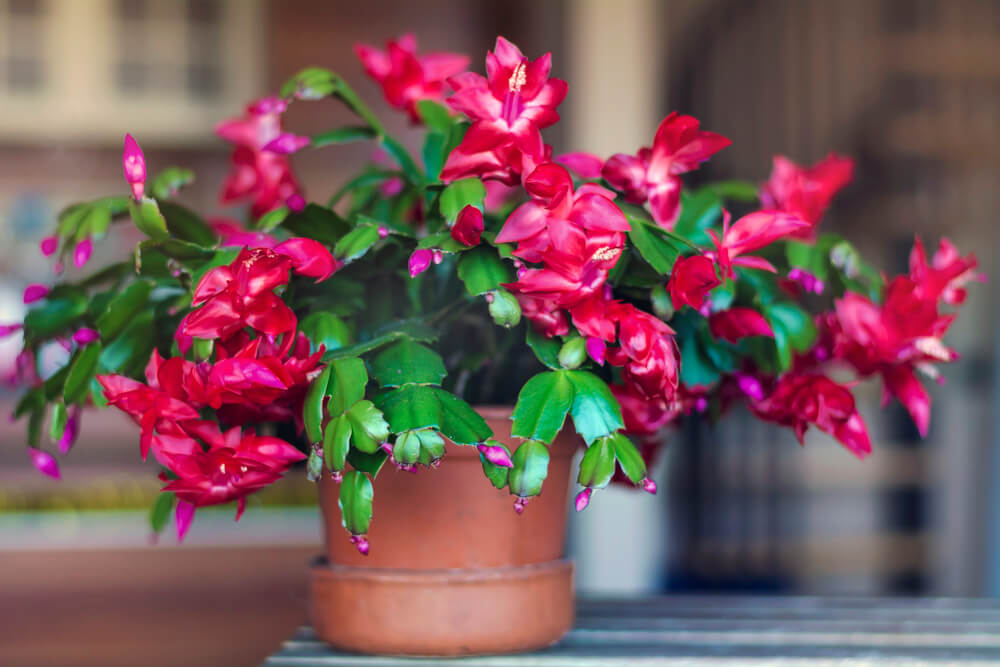
Originally the Christmas Cactus grew on the rainforest floor. So it’s no wonder it adores humidity along with filtered light. They need a little more water than typical succulents. Too much, however, will lead to root loss (among the top reasons this plant dies). So, shop for a container with plenty of drain holes.
You can achieve a great nesting place for your Christmas Cactus if you have an east-facing window in the bathroom. Just make sure they are not left in direct sunlight. The leaves are sensitive and bleach as a result.
Taking your plant for a “walk” is okay. You can put the Christmas Cactus outdoors in the summer, provided you have a shady spot for it. When you know the temperatures are going to drop below 50°° F, move that plant back into the house.
You’d be hard-pressed to find a plant that propagates as easily as the Christmas Cactus. Take a cutting from an area where you can get 2-3 “joints.” Dry these for two days. Move them into a rooting medium (or potting soil). Moisten them. Rooting takes place within 3 weeks, which is when new growth peeks through. Pinch them back gently. It encourages branching.
Types of Popular Christmas Cactus (S. x buckleyi)
There are three main types of holiday cactus, the Christmas Cactus, Thanksgiving Cactus, and Easter Cactus. You may remember the Christmas cactus from your grandmother’s home. She may have then gifted new plants to other family members, making them generational! This is the latest bloomer of the three (November – January).
The Thanksgiving Cactus starts blooming in November and continues until around late December. The square-shaped leaf segments with pointy hooks gave rise to the nickname “crab cactus.” What about Easter?
Well, if you have a holiday plant and haven’t identified it yet, spring flowers (March-May) are an excellent indication of an Easter Cactus. It has showy, trumpet-shaped flowers in pink, red, orange, and other shades of cherry. When the petals start closing, sunset is soon to follow.
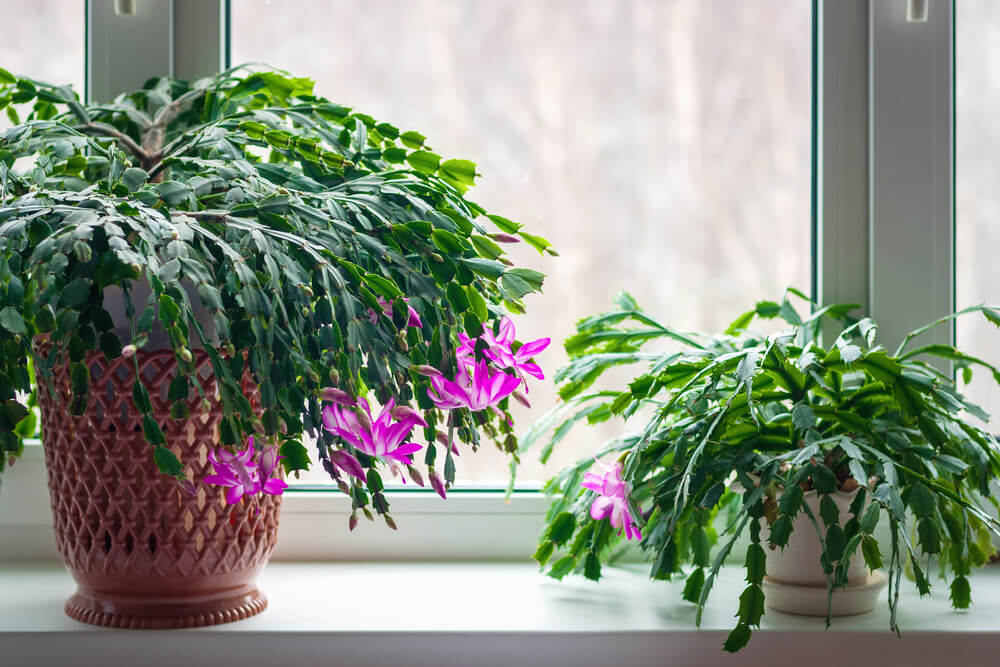
Christmas Cactus Cultivars
- Buckley’s Christmas Cactus: A dapper plant with brightly colored pink, orange, or red flowers lasting through winter. It’s very low maintenance and a good choice for new gardeners. By the way, some of the Buckley series have yellow flowers, too.
- Dark Eva: Flowering in early Winter, this Christmas Cactus has dark purple buds, opening to white flowers topped with lavender.
- Christmas Cactus-new Variety (Schlumbergera bridgesii) has a bohemian feel. It blooms for a long time indoors. Flowers appear perched on flatted green segments, sweeping backward to show off long, lush stamen.
- Kautsky’s Christmas Cactus: Breathtaking pink to red flowers that grow throughout the holiday season. Also, sometimes orangish.
- Lavender Christmas Cactus (Madame Butterfly): Elongated petals edged in light purple, showing off the crisp white interior. Blossoms in early December.
- May Christmas Cactus (Schlumbergera Gaertneri)i: While the name may seem contrary, May is the month in which this flower blossoms in Brazil (Southern Hemisphere). They’re feathery pink, looking light on the breezes.
- Schlumbergera Lutea: If you want sunshine in winter, this is the Christmas Cactus for you. It has nearly glowing yellow blossoms.
- Schlumbergera Microsphaerica: Pink, red, pale yellow, or white flowers blossom with beauty. Their segmented stems flatten out and look like a crab’s claw.
- Schlumbergera Orissichiana: This plant’s flowers appear pink to white, opening up much like an umbrella. They grace the later winter, around February.
- Thor Brit: nearly gold hues in the petals. The stamens are pink through and through. The Christmas Gold version has purple buds and gold flowers with blush stamens. The White Christmas variety has a delicate, creamy petal.
- White Christmas: Flowers appear in late December. The cactus reaches up to 1 foot tall when mature. It bears double-looking flowers in vibrant white.
- Xmas Fantasy: A wonderful peachy Christmas Cactus. These blossom in late December.
Live Long and Blossom: Plants in the Holiday Cacti group can have very long lives. With proper growing conditions, these plants can possibly live over 100 years.
Water Techniques for Christmas Cactus
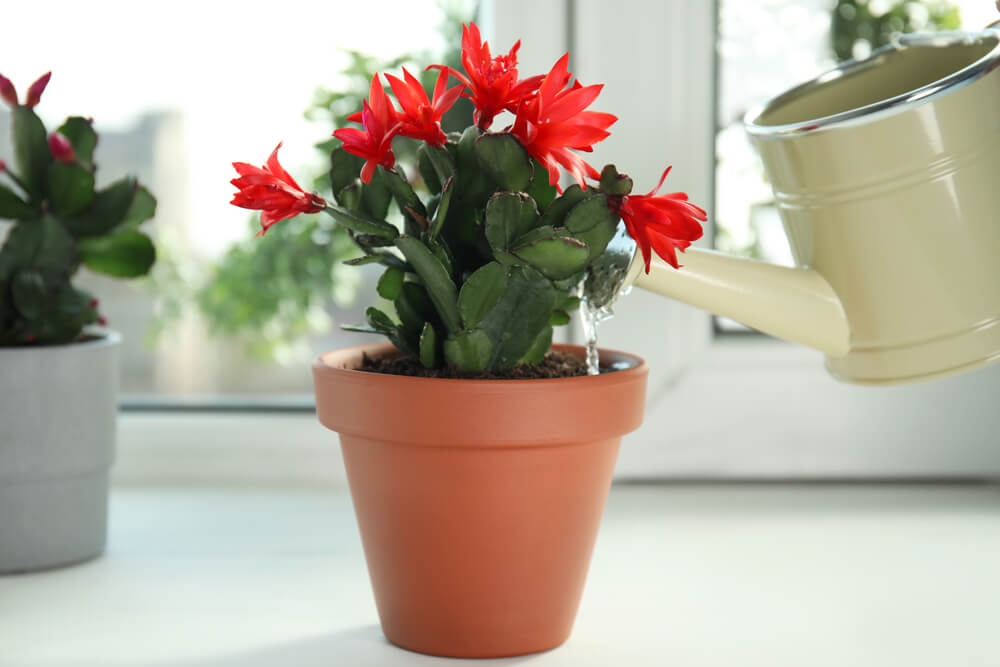
Only water your Christmas Cactus when the first 2” of soil feels dry. At this point, add water until lit runs through the pot’s drainage hole. Discard excess water caught from the drain holes in the container. Generally, this means watering your Christmas Cactus every 2 to 3 weeks.
Christmas Cacti appreciate humidity. So, fill the saucer under your pot with pebbles. Add water until it reaches just below the pebbles’ tops. Make sure your plant isn’t directly in water. Additionally, mist your Christmas Cactus daily, just 2-3 squirts.
While it might be tempting otherwise, experts tell us to water Christmas Cactus from the bottom. You can see exactly how much water reaches the roots.
Holiday cacti like Christmas Cactus are true cacti. It has a cousin in prickly pears!
Potting and Repotting Christmas Cactus
The two most important choices you have to make before potting your Christmas cactus are the container and the soil. Drainage in the bottom of your pot is nothing less than essential. Clay and terracotta are both fine options for plant crocks. Soil-wise, you want lightweight soil that doesn’t compact easily. Most mixes formulated for succulents do the trick.
Look for a container that’s 2” wider than the pot within which you bought your plant. It gives the cacti room to breathe.
You have now just set yourself up for transplanting, too.
Transplanting / Repotting
Nearly all potted plants will need transplanting from time to time. The most common reason for repotting is the plant outgrows its home. During its stay, the Christmas Cactus used a lot of the soil’s nutrients to keep it growing strong. So, when you’re repotting, fresh soil is always a good idea.
While Christmas Cacti are resilient, without water, plant death can take place over years before being noticed. Remain mindful of the signs of stress in your cactus. The flowers may reduce dramatically, flower buds never form, stem segments fall off, and shriveling stems are things for which to watch. Too much water can likewise cause root stress.
The goal of the indoor gardener is to prevent more problems than they have to cure. Routinely repotting your Christmas Cactus every 4 years. This is an ideal time to inspect the roots, clipping away anything that looks soggy or black. If your plant is large, you should stalk it for support until new feeder roots form.
If you want to encourage more blooming in your Christmas Cactus, keep it cool after its blossoming period (50 degrees). Give them just a little moisture; no fertilizer. Next, move the plant to a warmer location in the house (55 f – 65 F). It’s time to begin a cycle of timed light and darkness. Give them 10 hours of light and 14 hours of darkness daily. When buds appear, move the plant again into a prime, warm location. The process takes about 6 weeks from start to flower, so plan accordingly if you want them for a special occasion.
Christmas Cactus Pruning and Maintenance
Pruning your Christmas Cactus encourages branching, but only after the flowering cycle is over. Clip carefully where two branches join (where the plant naturally breaks). Two more will appear in its place.
Because Christmas Cacti grow rapidly, pruning keeps them shapelier and healthier in that you don’t have old, dead stems hiding in the greenery. Cut back your indoor plant every few years so it looks fresh. Never prune or trim more than one-third of your plant’s foliage at a time. That’s plenty for size reduction. More risks bloom prevention.
Deadhead a Christmas Cactus? Removing spent blossoms will encourage more flower production and potentially prolong its blooming season.
Christmas Cactus Blooming and Resting Periods
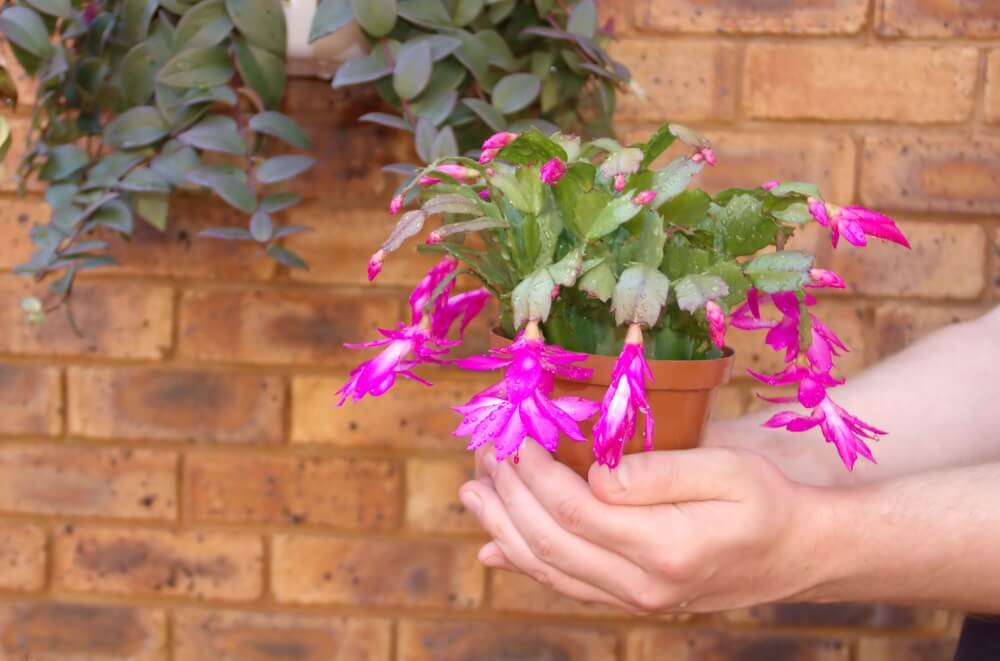
If you watch the earth’s cycle, it rapidly becomes obvious that some plants need nap times. The Christmas Cactus is among them. You can achieve this by keeping your plant in a room where lights remain off all night long (for at least 14 hours) until the flowers appear. Then you can turn on the lights at night.
Please Don’t Move Me You see flower buds forming nicely on your Christmas Cactus’s stems. It’s natural to become excited. But out of nowhere, it seems there’s no progress. It’s as if your plant is on strike. This is called bud blast. The major culprit behind the bud blast is you moving the plant AT ALL. No, not even the pot for dusting. When buds form, take care to leave the plant in place.
Common Pests & Plant Diseases
There are certain pests that just love the taste of cacti, including spider mites, scale, and mealybugs. Mealybugs are common among indoor plants. Over time, they turn into cottony masses. Pick them off with tweezers or use an insecticide for bad infestations.
Spider mites are tiny but leave behind telltale webbing. Use an insecticidal soap spray.
Gnats are itty-bitty. Wet soil is their favorite housing spot. When the infestation becomes large, you’ll start losing leaves in your Christmas Cactus. Use insecticidal soap, and put it into a clean pot with fresh soil.
If you start seeing damp, black lesions starting at the bottom of your plant and moving upward, you have soft rot. Sadly, the best thing is destroying infected plants. To avoid this in the future, water appropriately at the base of the plant.
Foliage turning gray-green, accompanied by plant wilt, is a fungus issue that can lead to plant collapse. Good drainage is the best way to avoid this problem.
A Christmas Cactus has little sharp points at the top of its leaves, which creates conflict. Its white flowers may deter negative chi energies. Even so, Christmas Cactus isn’t a good indoor Feng Shui choice.
Troubleshooting Common Christmas Cactus Problems
- Branches Droop: Larger plants have trouble supporting their branches. Prune them and then repot in a slightly larger container with fresh soil.
- Dropping Flower Buds: Caused by swift changes in temperature. Avoid areas in the house where there are cold drafts or heaters set on high.
- Excessive buds: While you might love these, your plant will need support. Christmas Cactus is also, to some degree, self-pruning, so you don’t have a lot to worry over.
- Wilting when soil is wet: You are over-watering. Let the cactus dry out, and watch for good drainage.
Folklore Surrounding the Christmas Cactus: One story from Bolivia tells of a Jesuit missionary by the name of Father Jose. The strain of sharing the faith became daunting. On one Christmas Eve, he prayed to God for guidance. A short while later, the villagers started singing a hymn he taught them. The children marched into the church with armfuls of bright flowers gathered for the Christ Child. Those flowers were the Christmas Cactus.
[wp-faq-schema title=”Frequently Asked Questions About Indoor Christmas Cactus” accordion=1]Summary
A Christmas Cactus will talk to you if you pay attention. When you see healthy green leaves topped with flowers, your plant says, “It’s all good.” On the other hand, if your cactus drops its flowers, it’s usually due to a sudden change in temperature; it’s saying, “brrrr”. Make sure it’s not near your air conditioner vent. Easy fix, right? That simplicity sums up Christmas Cactus care perfectly.

